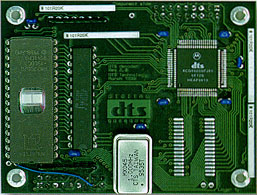DTS - DIGITAL SURROUND EXPLAINED

by David DelGrosso, Director of Marketing, DTS Technology, Inc.
October 1996
Sound is a 360-degree experience. And whether we are attending a concert
hall or a motion picture theater, the full emotional impact of the live
presentation is the result of a wide variety of sonic vibrations that arrive
from every direction...not just the sounds that are directed as us from
the front speakers.
In fact, many of today's movie theaters and concert venues utilize multiple
speaker placements, not only to reinforce the spatial depth of the sound
system, but to deliver specific information that is intentionally placed
behind us or to the sides...to more accurately represent the total creative
vision of the artists and producers. That's why most industry experts
agree that the evolution of home audio reproduction, which led us from
mono to stereo, is about to take a quantum leap into the spatial realism
of descrete surround sound.
Digital Theater Systems...
In 1993, Terry Beard, founder and President of Digital Theater Systems,
completed the development of a unique system for replacing the limited
analog soundtracks of motion pictures with a patented CD-Rom based format
that synchronized a 6-channel digital soundtrack...with only the SMPTE
timecode printed directly onto the film. Utilizing an unprecented technology
for encoding and decoding six discrete channels of superb digital audio,
the DTS system was ready to change the way we experienced movies in our
local theaters.
Upon completion of a rigorous test evaluation by movie producer Steven
Spielberg, an historical decision was made. For despite the enormous risk
of debuting this brand-new technology on a blockbuster mega-budget film,
Mr. Spielberg was determined to deliver his upcoming movie, Jurassic
Park, with the added sonic realism of a DTS digital soundtrack.
Needless to say, the co-venture proved to be a tremendous success. In
fact, the DTS experience was so gratifying that both Mr. Spielberg and
the motion picture studio, MCA/Universal, immediately invested in Digital
Theater Systems, and have since committed all of their major film productions
to this state-of-the-art technology.
After only three years, the DTS digital playback system is already installed
in more theaters around the world than Dolby Digital and Sony SDDS combined.
And the rapidly-growing list of award winning DTS-encoded soundtracks
now includes the Oscar® winner for Best
Picture, Braveheart and the winner for Best Sound, Apollo
13...and virtually every recent blockbuster, including Twister,
Mission Impossible, and Independence Day.
Introducing DTS Technology...
Recognizing the crossover value of this invention for home theater sound systems, Digital Theater Systems then created a wholly-owned subsidiary called DTS Technology, with the singular goal of delivering the finest multi- channel sound possible, for all home, car and professional audio applications.
After years of intensive research and development, a similar encode/decode discrete technology is now available via a single Motorola chip that can be affordably installed into any 6-channel surround-system processor (technically 5.1 channels, which means 5 full-range channels, plus a sub-woofer).
The new DTS-Digital Surround algorithm is designed to encode the 5.1 channels of 20-bit audio onto any compact disc, laserdisc or DVD...with considerably less data-compression than any other competng system. A DTS-encoded disc can then be played back on any disc player with a built-in digital output connector.
The digital bitstream from this output is fed directly to any surround processor that incorporates the DTS decoding chip which then separates the digital information into 5.1 playback channels that are sonically identical to the original masters.
Multi-channel Movies...
The first obvious application for this technology is to produce new Digital Surround versions of the more than 200 motion pictures that utilize a DTS soundtrack for their theatrical release. And in December [1996], Image Entertainment will become the first manufacturer of DTS-encoded laserdiscs for consumer purchase, including the world's first 5.1 discrete soundtrack of Jurassic Park. [Release of these discs occured on January 15, 1997.]
As the finest technology currently available for home video entertainment, the laserdisc format can now easily be adapted to include DTS audio soundtracks, by mastering the 5.1 encoded audio channels instead of the 2-channel digital tracks. At the same time, each DTS-encoded laserdisc maintains the original analog stereo tracks to allow stereo playback in the absence of a digital decoder.
For Digital Surround playback, a DTS decoder is required
in order to separate the digital data from the disc player into the 5.1
individual channels encoded onto the digital tracks.
This investment will
vary dramatically depending upon which components are already a part of
your main system. For example, if you begin with a stereo receiver with
no pre-out or main in connectors, then purchasing a new discrete 6-channel
receiver (or separates) is the only way to convert ot Digital Surround.
However, you may be able to add a separate "surround sound" decoder to
your existing stereo system if you already have the proper connections.
Either way, it is highly recommended to consult with an audio/video speciality
retailer who can easily explain the proper system upgrades.
It's important to note that any audio component that already offers some
form of descrete surround capability, such as Dolby Digital (formerly
known as AC-3), can now integrate an affordable DTS chip into their circuitry
design...and instantly increase the entertainment value of your home theater
system.

Multi-channel Music...
In addition to these new movies on laserdisc, many exciting new multi-channel
music recordings will also become available in the form of DTS-encoded
compact discs. The sonic realism of Digital Surround music discs dramatically
trancends the old "quad" recordings of the Seventies by offering new 5.1-channel
re-mixes of your favorite albums of all time...with better-than-compact-disc
sound quality. And the new multi-channel recording sessions scheduled
for later this year [1996] will change forever the way we experience music
in the home, and eventually with our car audio systems as well.
All DTS-encoded movies and music recordings are compatible with the 5.1
speaker configurations that are currently available for home theater systems.
And while it is anticipated that most multi-channel movie soundtracks
will utilize all five-full range channels, plus the Low Frequency Effects
(.1) sub-woofer channel, music recordings on compact disc will vary in
terms of how each artist/engineer/producer chooses to mix their multi-channel
master.
For optimum playback of all future recordings, it is highly recommended
that full-range, equally-matched loudspeakers are utilized for all five
of the main channels (including the "surrounds").
The Evolution of Audio...
First there was mono...then there was stereo. But as we now begin the
evolution into Digital Surround systems, we can imagine someday reminiscing
about the "old days" when we all settled for a system with only two speakers...and
how incredible a descrete 360-degree audio systems sound in comparison.


